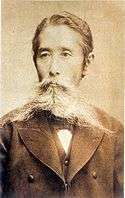Japanese general election, 1890
| | |||||||||||||||||||||||||||||||
| |||||||||||||||||||||||||||||||
| |||||||||||||||||||||||||||||||
|
| |||||||||||||||||||||||||||||||
| Results of the Japanese General Elections, 1890 | |||||||||||||||||||||||||||||||
| |||||||||||||||||||||||||||||||
 |
| This article is part of a series on the politics and government of Japan |
|
Related topics |
|
|
Japanese general election of 1890 (第1回衆議院議員総選挙 Dai-ikkai Shūgiin Giinsōsenkyō) was the Empire of Japan’s first general election for members of the House of Representatives of the Diet of Japan. It was the first example of a popularly elected national assembly in Asia [1]
History and background
Japan’s first general election for the lower house of the national assembly was held on July 1, 1890, in accordance with provisions of the new Meiji Constitution, which had been promulgated in 1889.[2]
The election was based on limited suffrage, with only male citizens 25 years of age and over, who had paid 15 Japanese Yen or more in national taxes, and who had been resident in their prefecture for at least a year, qualified to vote. The number of eligible voters who met this requirement was 450,872 people out of a total Japanese population of 39,933,478 (1.13%). The high tax requirement meant that voter roles were heavily weighed towards rural landlords and urban entrepreneurs. In terms of social class, 91% were commoners, and 9% were ex-samurai.[3] Residents of the prefectures in Honshū, Kyūshū and Shikoku participated; residents Hokkaidō and Okinawa (as “territories”) were excluded from this election. About 95% of those eligible to vote actually cast ballots, although there was no penalty for not doing so.[4]
Only male citizens 30 years of age and over, who were not members of the kazoku peerage or of the imperial family or its branches were allowed to become candidates for office in the lower house. The number of seats in the lower house was 300, divided into 214 single-seat districts and 43 two-seat districts, which were contested by 1,243 candidates. The election went smoothly and without violence reported.[5]
On November 25, 1890, after the election, first Diet session was summoned; the two opposing forces confronted each other for the first time in the arena of practical Japanese politics. The so-called mintō (liberal parties: the Jiyutō, the Rikken Kaishintō and their affiliates) held a combined strength of 171 seats, forming the majority.
Election results
| Political Party | Seat |
|---|---|
| Jiyutō (自由党) | 130 |
| Taiseikai (大成会) | 79 |
| Rikken Kaishintō (立憲改進党) | 41 |
| Kokumin Jiyutō (国民自由党) | 5 |
| Independents (無所属) | 45 |
| Total | 300 |
Notes
References
- Jansen, Marius B. (1989). Cambridge History of Japan: Vol. 5: The Nineteenth Century. Cambridge University Press. ISBN 0-521-22356-3.
- Fraser, Andrew (1995). Japan's Early Parliaments, 1890-1905: Structure, Issues and Trends. Routledge. ISBN 0-415-03075-7.
- Keene, Donald (2005). Emperor Of Japan: Meiji And His World, 1852-1912. Columbia University Press. ISBN 0-231-12341-8.
- Mason, R.H.P. (1969). Japan's First General Election, 1890. Cambridge University Press. ISBN 0-521-07147-X.
- Meyer, Milton Walter (1992). Japan: A Concise History. Rowman & Littlefield. ISBN 0-8226-3018-4.


